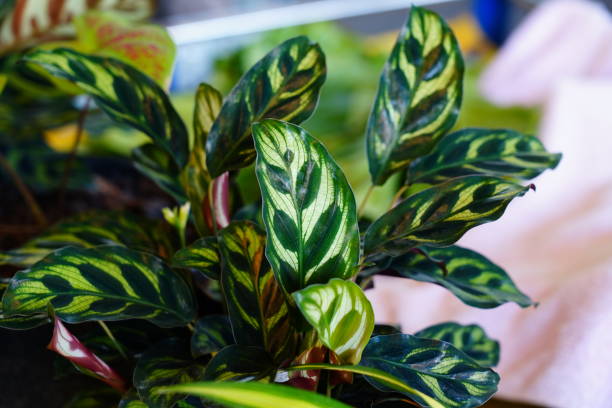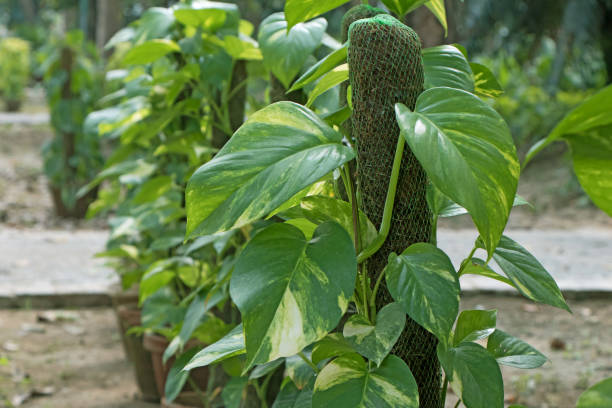How to Grow and Care for Pussy Willows

Several species of smaller willow trees in the Salix genus are commonly known as pussy willow due to their furry catkins appearing in early spring. Salix discolours, a deciduous shrub native to North America, is the most frequently referred to as pussy willow. Still, two European species, S. caprea and S. cinerea, are sometimes called by this name. These plants bloom in early spring, with their fuzzy catkins being one of the earliest signs of the season.
People often cut and preserve the branches of these plants for decorative arrangements. Although pussy willows are commonly found in wild wetland areas, you can cultivate them in your garden if the necessary conditions are met. These plants can be shown to their full potential in your landscape with careful pruning.
Pussy willow plants grow rapidly and can spread quickly, with some species reaching up to 25 feet. By simply planting a pussy willow branch in the soil, a fully developed adult plant can be obtained in a few months. Planting is typically done in the spring but can also be done during the summer successfully.

| Name | Glaucous willow, Pussy willow |
| Botanical Name | Salix spp. |
| Belongs to | Salicaceae |
| Type of Plant | Shrub |
| Size | 4–15 ft. wide, 6–25 ft. tall, |
| Sun Exposure | Full, partial |
| Type of Soil | Loamy |
| pH Of Soil | Neutral |
| Time of Bloom | Spring |
| Color of Flower | White |
| Zones of Hardiness | 4–8 (USDA) |
| Area | Europe, North America, Asia |
Pussy Willow Care
To care for pussy willows, it is important to remember that they are typically found in wetland habitats and require plenty of water. For this reason, they are a great option for areas of your garden with poor drainage. Remember that willow have invasive roots, so it is best to plant them far away from septic tank fields, sewer lines, and water lines. Proper pruning can also help keep pussy willows more compact and shrub-like. Since willow plants are relatively weak and brittle, pruning can also help prevent damage from snow and ice.
Pussy willows are dioecious, meaning they have separate male and female trees. The male trees produce attractive white catkins that yield numerous tiny flowers full of pollen in the later part of spring. Once the blooms reach this stage, they are no longer considered decorative for floral cuttings. Female trees produce their own catkins, which bear flowers that receive pollen from the male trees through flies and bees. Once the catkins have appeared, the plants develop typical willow shrub features, including dull green, lance-shaped leaves.
Warning
It’s worth noting that while Salix discolours, a native North American plant, is not officially considered invasive, other foreign species, such as Salix caprea and S. cineraria, have naturalized and are considered invasive in some parts of the Northeast and North-Central United States. Additionally, all weeping willow species are aggressive growers with tough, penetrating roots that can clog sewers and drains and take over garden spaces.
Tips for Taking Care of Pussy Willow

Light
Pussy willow plants prefer full sun, although they can tolerate some shade.
Soil
These plants grow best in moist, rich loamy soil and constantly prefer damp soil. Although they can grow in poorly drained soil, they perform better in well-drained, constantly moist soil.
Water
Pussy willows thrive in wet conditions and are frequently found near streams in the wild, where they help control soil erosion. Make sure they receive sufficient water and avoid drought conditions. In dense, water-retentive soil, 1 inch of rain/irrigation each week is often enough. However, in porous soil, your pussy willow may require more frequent watering to maintain a constantly damp soil environment.
Temperature and Humidity
Pussy willows grow best in temperate regions with cold winters, typically in the Northern United States and Canada (zones 4 and 5). They grow more slowly in warmer climates (zones 6 to 8). They tolerate high humidity well.
Fertilizer
Compost or leaf mould alone can help pussy willows thrive. Once the plant is over one year old, fertilize it once in the fall with a balanced fertilizer. Spread 1/2 pound of fertilizer per 1/2 inch of base-trunk diameter, extending 18 inches beyond the branches’ drip line. Avoid contact between the fertilizer and the plant’s trunk.
Types of Pussy Willow
Pussy willow is commonly used to refer to Salix discolour, a native North American plant. However, several other Salix species also bear the same name:
Salix caprea
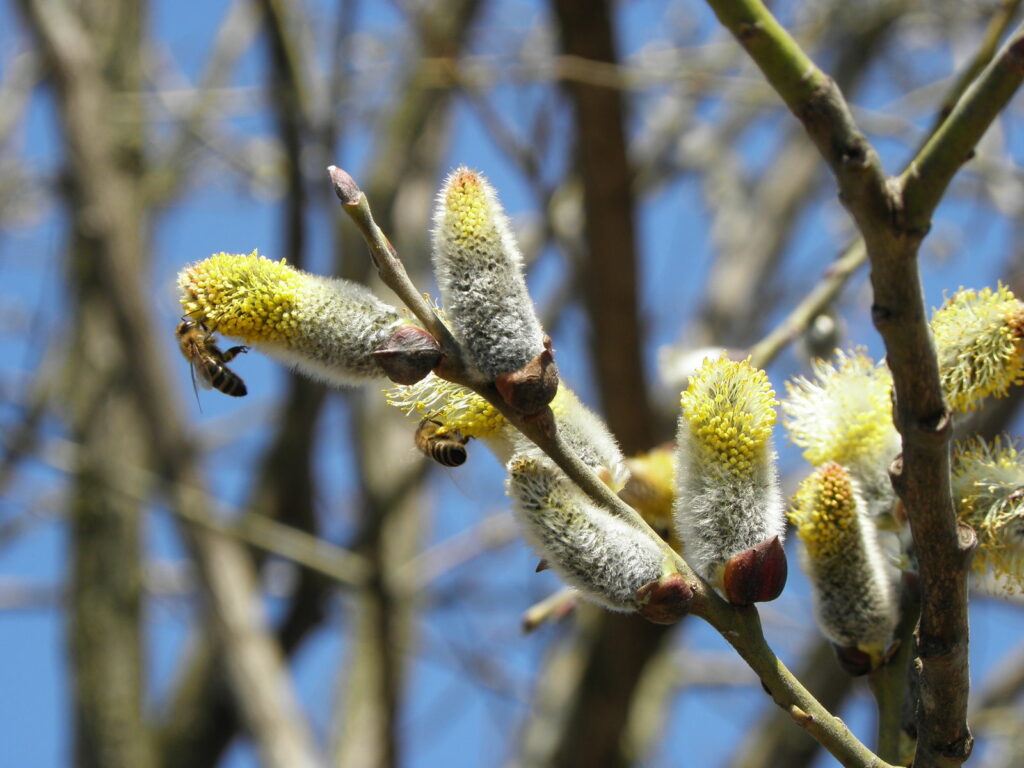
Also known as the goat willow, this Eurasian pussy willow is a distinct variety.
Salix caprea pendula
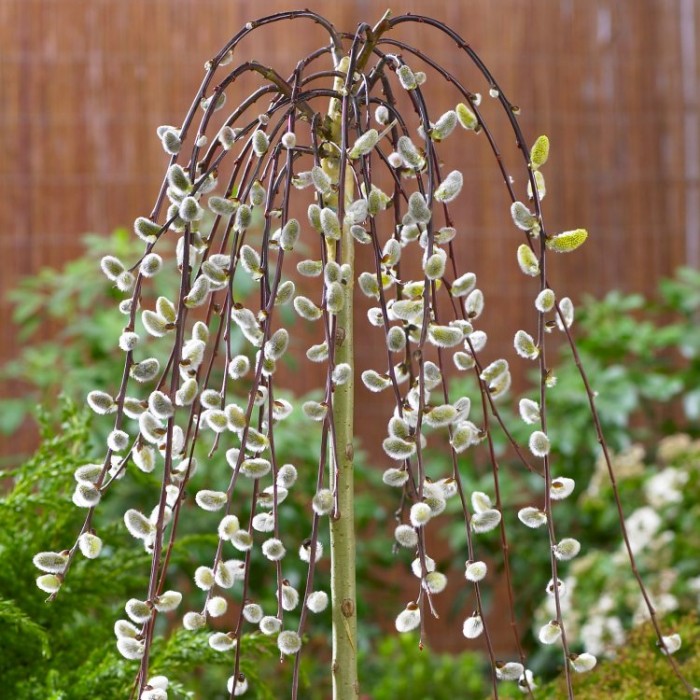
This is a weeping pussy willow that grows horizontally like a ground cover instead of upright like a bush.
Salix cinerea
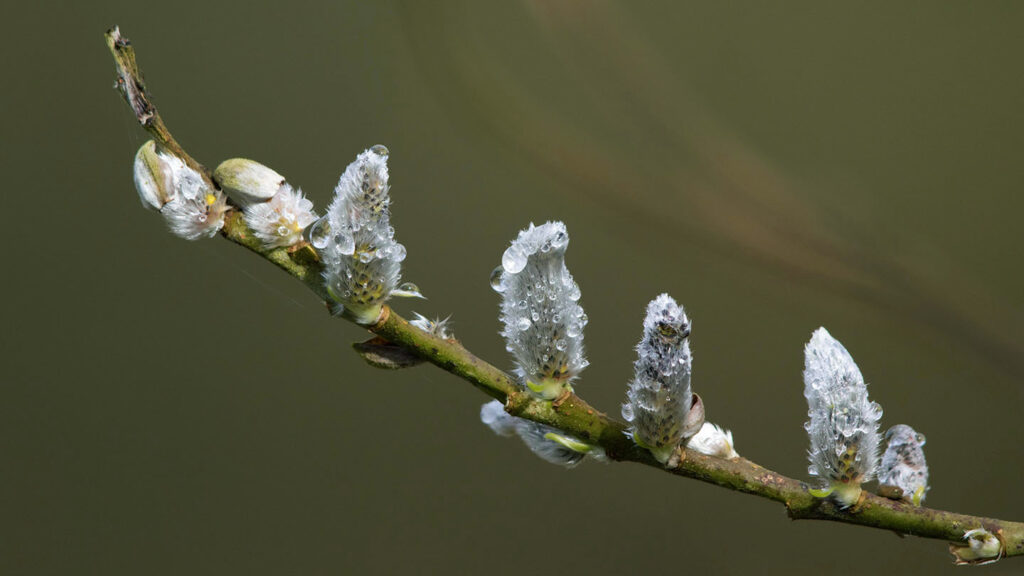
While this plant is native to Europe and Western Asia, it has naturalized in wetlands across the Eastern United States, and is known to be invasive, and should not be used as a landscaping plant.
Pruning
Pruning is essential for promoting new branches with ample space to grow and produce larger catkins while preventing diseases, fungus, and insect infestations. Pussy willow shrubs are ideally shaped in a rounded form, and drastic pruning can be used to restore the plant’s shape. Winter is the best time for major pruning while the plant is dormant.
To prune the plant annually, follow these steps:
- Harvest the tops of branches bearing catkins in late winter or early spring.
- In winter, remove any dead branches, then cut one-third of the oldest branches back to the ground.
- Determine where the newest branches are by looking for brown-coloured branches. Make the remaining cuts back to the level where the most unique branches are.
- Use sharp anvil pruners and make your cuts above nodes, with the most effective cuts being above nodes that grow on the outside of branches.
- Remove any branches crossing over each other, which will help maximize the number of catkins.
- This pruning process carried out yearly for three years, will keep the shrub fresh and vibrant.
Creating New Pussy Willow Plants
To propagate new plants, there are two methods for pussy willows; stem cuttings or seeds. However, most gardeners prefer the stem-cutting method as it is simple and effective. It can even establish a living fence by planting a row of stem cuttings. Here are the steps for the stem-cutting method:
- Using bypass pruners, cut a 1-foot-long stem of green and flexible growth from the new development rather than the older, grey-coloured branches.
- Insert the cut end of the branch, which should be as thick as a pencil, a few inches underground, with a couple of nodes showing above ground for stability.
- Make sure to water regularly and keep the soil damp. New roots and leaves will develop within a few weeks, and growth will be rapid.
- If you do not want to wait until summer, root the stem cuttings in water indoors, and then transplant them outside when the danger of frost is past.
How to Propagate Pussy Willows from Seeds?
While stem cuttings are a popular way to propagate pussy willows, seed propagation is less common. Collect seeds from the catkins when they look cottony and sow them in a small container on the surface of the potting mix immediately with the silky seed hairs still attached. Keep the soil moist until the seeds germinate and sprout, then continue growing them until strong seedlings develop. At this point, you can transplant them into your landscape.
How to Cultivate Pussy Willows in Containers?
Pussy willows can be grown in containers, although it is typically recommended for younger plants due to their tendency to become root-bound and overgrown with age. To grow in pots, use a standard commercial potting mix in a large container with proper drainage. These plants are best grown outdoors year-round and are not suited as permanent houseplants. During winter, like most perennial plants grown in pots, they should be relocated to a protected location.
Due to their rapid growth, these plants will outgrow their pots quickly, necessitating repotting every couple of years and, if possible, dividing the rootball. Potted pussy willows require more frequent watering than those planted in the ground, often requiring daily watering due to their moisture-loving nature.”
Overwintering Techniques
“There are no special overwintering techniques needed for pussy willows, but it is advised to keep the plant adequately watered until the ground freezes in late fall.”
Common Diseases and Pests
Pussy willows are vulnerable to numerous diseases and pests, but they are typically vigorous enough to endure most threats without intervention other than removing damaged branches through pruning. Some common diseases include powdery mildew, leaf spots, grey scab, and cankers. Damaged branches or plants should be pruned out. Insect pests affecting these plants include aphids, scale, borers, lace bugs, and caterpillars, and pesticides may be required in severe infestations.
How to Preserve Pussy Willow Branches?
To ensure that willows form bloom clusters (catkins), the key is harvesting branches at the right time and preserving them in the most useful way for decorative arrangements. Preserving pussy willow branches involves picking them correctly and keeping them from receiving water. If the branches are kept in water for weeks, they will flower out and lose their beauty, so avoiding that is best.
Another approach is to harvest the branches before the catkins open. In late winter or early spring (depending on your location), you can collect branches with catkins that have yet to fully open and force them to open indoors. Here’s how:
The passage provides information on how to preserve pussy willow branches to use them for decorative arrangements. It advises picking the components at the right time and depriving them of water. One method is to harvest the branches before the catkins open and force them to open inside.
Instructions
- Look for swelling at the nodes along the branches of pussy willows, as this is the first indication of the catkins to come.
- Pick a day with temperatures above freezing to begin the operation.
- Cut a 2-foot-long branch and repeat for as many branches as desired.
- Place the bottoms of the branches in a vase filled with lukewarm water.
- Cut about 1 inch off the bottoms underwater to promote water intake into the branches.
- Add floral preservatives to the water, if possible.
- Wrap the exposed areas of the branches in damp newspaper or cloth to preserve humidity.
- Place the vase in a cool, dark spot for a day or two until the stems show colour.
- Remove the newspaper or cloth and place the vase in a cool spot (60 to 65 degrees Fahrenheit) in indirect sun.
- Mist the branches occasionally until the pussy willow catkins appear.
- After successfully forcing the catkins open, remove them from the water and preserve them for use in dried flower arrangements.
Common Issues with Pussy Willow
Pussy willows are known for their fast growth and large branches, but there are several concerns that may arise when cultivating these shrubs, especially when planted in the landscape. Here are some common problems and their solutions:
Yellowish-Green Leaves
Pussy willows tend to indicate that they need more sunlight when their leaves turn yellowish-green. The plant can be moved to a brighter spot if grown in a pot. However, if it’s planted in the ground, look for branches of other trees blocking the sun and prune them to allow more light to reach your pussy willow.
Cracking Branches
Willow branches are brittle and weak, so they may split or crack due to wind or heavy icing. Tying up branches and brushing off snow and ice buildup can prevent some damage during storms.
Wildlife Damage
Pussy willow branches are a delicacy for deer, squirrels, and birds and can be easily damaged by them. Protecting them with fencing or chicken wire is the best way to prevent wildlife damage.
TRY THIS AT HOME
Most cut pussy willow stems are preserved in a dried state without allowing them to reach their flowering peak. However, you can experience the full flowering and leafing-out process by keeping fresh-cut pussy willows hydrated. Choose a healthy-looking bunch with greenish, flexible stems that are not brittle or shrivelled and place them in a vase near a window, changing the water daily. You may also add a small amount of flower food if you have any.
Observe the new flower buds shedding their shiny brown bud scales and revealing the flowers. The yellow stamens will emerge to cover each catkin as the flowers mature. At each end, there is a tiny clump of pollen. If you wait a little longer, you may also see pale green, strappy leaves unfurl from the leaf buds. At this stage, your willow stems will be in full spring growth and can be planted outdoors in soil for an extended experiment. The flexible stems can also be used to make a wreath or compost.
Harvesting Pussy Willow
Pussy willows are a popular choice for flower arrangements, and harvesting them is a straightforward process. After the catkins have fully bloomed, simply cut a two-foot-long branch and place it in a vase without water to preserve it. Alternatively, you can cut a branch with unopened catkins and force them to bloom indoors. Here are the steps to follow:
- Select a branch. Choose a two-foot-long branch of pussy willow with swollen nodes indicating new growth from a shrub that has not yet bloomed.
- Soak the branch. Put the cut end of the branch in warm water in a vase.
- Cut the branch again. While the branch is submerged in water, trim an inch off the base to prevent air from reaching it.
- Cover the branch. Wrap the remaining exposed parts of the branch in a damp cloth or newspaper to prevent it from drying out. Place the vase in a cool and dark place.
- Take care of the branch. After a few days, remove the coverings from the branch and place the vase in indirect sunlight. Mist the branch regularly and keep the temperature around 60-65 degrees Fahrenheit until the catkins bloom.
Conclusion
In conclusion, pussy willows are a wonderful addition to any decorative landscape. Their delicate catkins and hardy nature make them easy to care for and thrive in various environments. Whether you want to create a natural privacy screen or add a touch of springtime beauty to your home, pussy willows are a great choice. With the tips and information provided, you can successfully grow, harvest, and preserve these lovely shrubs for years.
Some FAQs
Do pussy willows attract butterflies?
Viceroy and mourning cloak butterflies are known to be attracted to Salix discolour.
How long do pussy willows live?
With proper care, pussy willows can live from 20 to 50 years.
How can I use pussy willows in landscaping?
Pussy willows are ideal for boggy, damp areas and can also be used for stabilizing ponds or creek banks. They can also be pruned to create a casual hedge or provide privacy.
Why are the catkins on my pussy willows not very showy?
Female pussy willow plants usually have small, dull green catkins. Male plants have larger, pearly white catkins, preferred for decorative arrangements. So, it’s best to choose male plants for harvesting branches.
Where do pussy willows grow?
Pussy willows grow best in moist, boggy soils in cool to temperate climates. They are native to North America, Europe, and Asia.
How to grow pussy willows?
Pussy willows can be propagated by cuttings or planting seeds. They prefer full sun to partial shade and moist soil. They can be grown in a pot or in the ground.
What are pussy willows?
Pussy willows are a type of willow tree that produce soft, furry catkins in the early spring. They are commonly used in decorative floral arrangements.
How to do dry pussy willow?
To dry pussy willows, hang them upside down in a dry, well-ventilated area. It’s best to harvest the branches before the catkins fully open. Once they are dry, they can be used in dried floral arrangements or other crafts.
Related Articles
- Carnation Flower: Plant Care and Growing Guide
- How to Grow and Care for the Cast Iron Plant?
- Spider Lily: A Guide to Growing and Caring for this Stunning Flower
- How to Grow and Care for Pussy Willows
- Zebra Plant Care: Growing Aphelandra Squarrosa At Home
- 8 Prosperous Types of Money Plants in Feng Shui to Bring Wealth and Abundance
- A Comprehensive Guide on Growing and Caring for Majesty Palm
- How to Grow and Care for Baby’s Breath?
- Rhododendron Plant: Rhododendron Care In Your Garden
- Iris Flower – All You Want To Know About Them




